Hydraulic cylinders and valves are common on refuse machinery, as they bring the rugged power for controlling, lifting, filling, compacting and dumping in the many types of refuse vehicles used.
By Josh Cosford, Contributing Editor
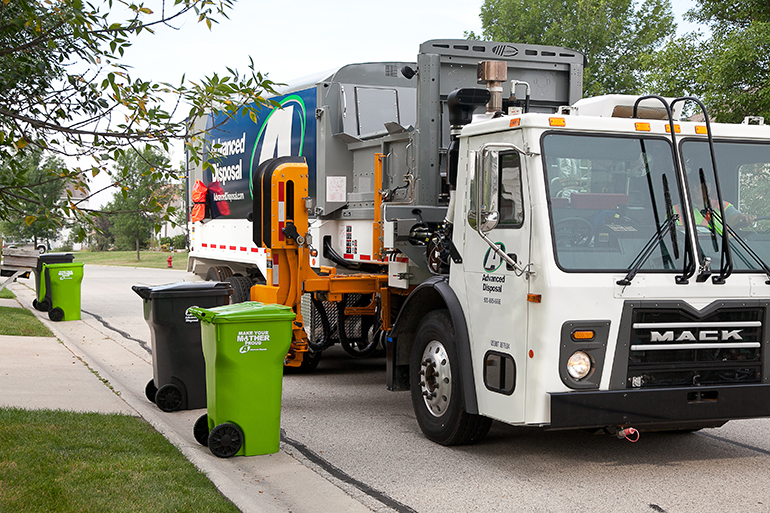
Waste management is an industry considered best operating in the wings, leaving the main stage orderly and immaculate. Sure, everyone sees a garbage truck occasionally, and you may even leave your city workers a Christmas present every winter. But few of us understand the path trash takes from our curb to either its place of reincarnation or place of final rest. And unless you’re the type of fluid power aficionado to be reading this article anyway, fewer people know how prolific hydraulics are in the waste management process.
Have you ever visited another state, province or country and seen a local piece of machinery seemingly designed on another planet? Dump trucks, concrete mixers and snowplows are often designed for and from regional preferences. Garbage trucks follow the regional recipe, so depending on municipal preferences, recycling requirements and the efforts of the salespersons offering products into that region, each locale may use a different machine.
The most common garbage truck (sometimes call a refuse truck), and the one most people think of, is the rear loader. The garbage is tossed into the gaping rear end and periodically compacted with what looks like a giant Hungry Hippo. It goes without saying these machines are heavily hydraulic powered, and these trucks indeed take advantage of hydraulic power density. The sweep blade and compactor action both use hydraulic cylinders. Older trucks required an operator’s thoughtful lever-operated directional control valve actuation to sweep and compact the trash. However, newer machines use either sequence valves or electronics to complete the action with one push of a lever or button.
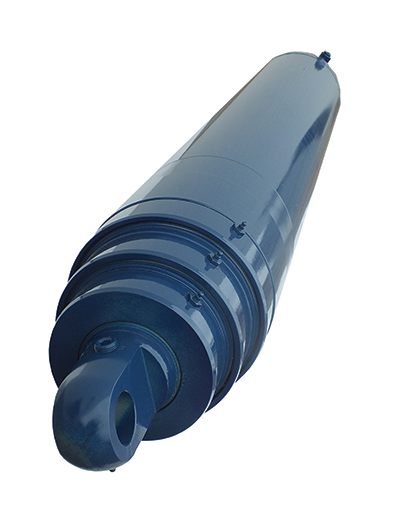
Hydraulics provide maximum productivity for garbage trucks, not only regarding cycle time, but the quantity and compaction rate of the garbage itself. Compaction rate refers to the density of trash per cubic yard of capacity after the material is compacted. Compaction rate is a measurement of mass per volume of space, rather than a time component. It is dictated by a combination of body strength, hydraulic cylinder force and the surface area of the compactor. A higher compaction rate provides more compacted material per cubic yard, improving productivity.
With more powerful compaction from heavy-duty hydraulics, a garbage truck reduces the frequency in which it exits its route to dump the load. An economically priced garbage truck may offer a capacity of only about eight cubic yards. With lighter-duty hydraulics, these smaller machines may only compact those eight cubic yards to a density of 800 lb each. With just a 6,400 lb load capacity, a smaller truck needs to dump more frequently.
Larger, more expensive trucks employ larger sweep and compactor actuators, sometimes up to dual 6-in. bore cylinders. At a nominal working pressure of 3,000 psi, those two 6 in. bore cylinders can achieve maximum force over 80 tons combined. A capacity over 30 cubic yards in these larger trucks combined with more compaction force enables each one of those cubic yards to hold more raw waste. Instead of 800 lb per cubic yard, think more like 1,300 lb per cube. The large truck crams more garbage more effectively, now carrying over 39,000 lb each haul, vastly reducing dump frequency and thereby increasing productivity.
Although the body capacity and compaction rate vary, so too does the method of filling the body. Front-load trucks primarily service commercial customers, looking much like mastodons as their giant “tusks” lift dumpsters over their back to empty them into their open hopper. Front-load garbage trucks are often larger than some of the rear load counterparts, and with so much material to compress, they experience reduced compaction rate. Also, commercial waste tends to be filled with dense, mixed-media trash such as metal or wood, where residential garbage collected is primarily soft household waste.
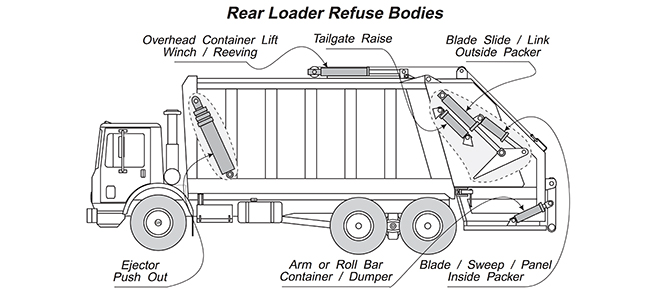
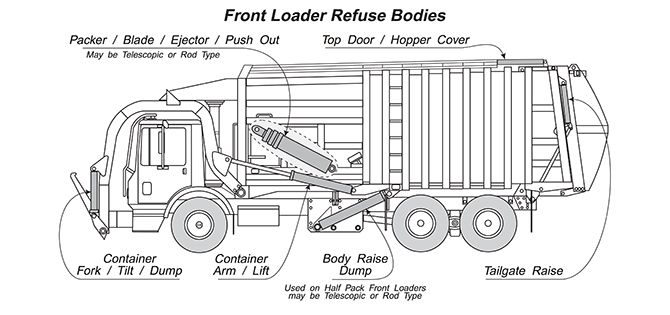 The front and rear load trucks each operate using roughly the same number of actuators. The rear loader is equipped with sweep cylinders pulling the hopper trash up into the body where it’s compacted. In contrast, the front load truck uses two sets of cylinders each to operate the forks and arms. The arm cylinders are equipped with counterbalance valves, since the mass of the dumpster goes over-center, turning the tension load into a compression load.
The front and rear load trucks each operate using roughly the same number of actuators. The rear loader is equipped with sweep cylinders pulling the hopper trash up into the body where it’s compacted. In contrast, the front load truck uses two sets of cylinders each to operate the forks and arms. The arm cylinders are equipped with counterbalance valves, since the mass of the dumpster goes over-center, turning the tension load into a compression load.
The most recent truck to the game is the side loader garbage truck. This truck uses multiple cylinders to dump a standard-issue garbage bin into the truck’s side hopper. Hydraulic actuation extends the grapple mechanism (a surprising distance, sometimes), the grapple arms clamp the bin and drag it in flush to the truck where cylinders lift and dump the bin contents into the hopper. The hydraulic system works in reverse to lower and replace the bin to the curb. Electric valves operate the many cylinders used for the bin handling functions, and some modern machines employ automatic or semi-automatic bin dumping operation, vastly improving productivity.
We have all seen garbage trucks collecting trash, but so few of us have seen where they unload their less-than-precious cargo. Trash has to go somewhere, and that first somewhere is a transfer station. What nearly all garbage trucks share in operation is their method of dumping trash at the transfer station, where they operate as dump trucks. After unlocking their hydraulic tailgate latch cylinders, their large tailgates open using two hydraulic cylinders, looking much like a giant clamshell. Once the tailgate is high in the air, a telescopic cylinder tilts the body and dumps the trash into a pit where it is processed. Some trucks, however, use their compactors to push trash out the body and into the pit, although this method is less common.
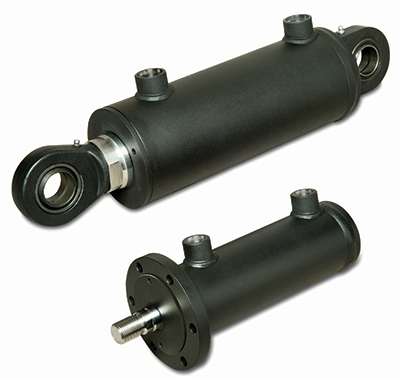
The most advanced garbage trucks now take advantage of hydraulic hybrid technology. Rather than relying on the brute force from its diesel engine, a hydraulic pump/motor mounted to the transmission PTO both delivers and accepts hydraulic energy. When the vehicle slows for loading, the pump circuit sends fluid into a hydropneumatic accumulator to store energy. As the truck once again accelerates toward the next home, the pump switches to motor mode. The accumulator feeds its stored energy back to the system to supplement the diesel motor with a massive burst of torque. The hydraulic hybrid concept is ideally suited to the garbage truck’s repeated stop/start cycles in city waste collection.
Hydraulic machinery continues to play a part in the post-collection processing of trash, but how handling occurs depends on the municipal and local regulations. The transfer station likely puts sizeable front end loaders into action to process the unyielding inflow of garbage. The front end loader is a workhorse — quickly transitioning between forward and reverse movement, lifting and dumping trash as required. New loaders are optioned with electric hybridization, turning the wheel motors into regenerative brakes, similar to how the garbage trucks recoup energy, but this time storing them in batteries.
The two final destinations most common for waste are either incineration or landfill. For incinerated waste, a transfer station makes sense when built near the incinerator. Front end loaders fill staging area with waste fuel (garbage), where a giant crane equipped with a hydraulic grapple takes fistfuls of waste and dumps them into a gaping hopper. This hopper funnels the waste down below where hydraulic pushers send the waste into the burning inferno. Some incinerators power steam turbines to create electricity, while others burn the waste into dust.
For landfill waste, instead of fueling incinerators, large 53-ft trailers are filled for transportation to landfill sites. You’d correctly assume that landfill sites also count on hydraulic machinery. If the 53-ft trailer isn’t already capable of dumping with a humungous telescopic cylinder, then some trailers are parked upon platforms which themselves lift to dump the trailer while the semi-truck is still attached!
Thousands of tons of waste are processed at landfills every day, where a combination of loaders and dozers lift, push and spread the incoming garbage. Hydraulic equipment aids waste management every step of the way to take waste from your curb to its final resting place out of sight and out of mind. The power density, controllability and all-weather capability of fluid power perfectly suits the needs of the waste management industry.

